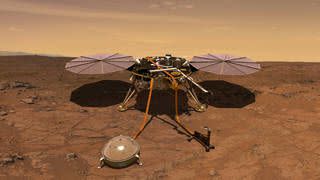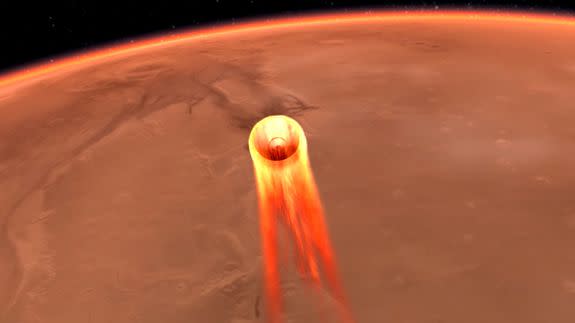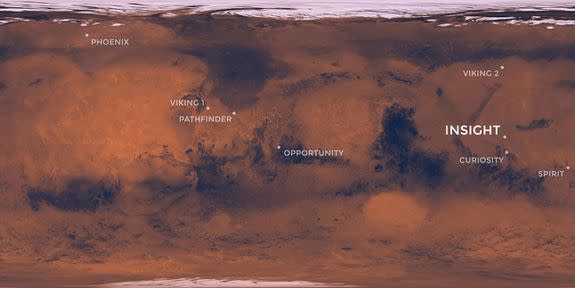NASA's latest and greatest Mars lander will touch down on the red planet Monday

NASA's InSight lander has been hurtling through the solar system for over seven months. Now its time has come.
InSight is set to land on Mars.
InSight — sent to observe Martian earthquakes and study the planet's ancient interior — is expected to land in a flat, barren plain on Mars on Monday at around 3 p.m. ET.
Plummeting down to Mars is always perilous, so NASA mission controllers — and InSight's adoring public — will anxiously await the landing results back on Earth.

Image: nasa
NASA's choice of landing site, called Elysium Planitia, will give the stationary lander a flat place to deploy its seismometers and drill into the frozen ground.
Located some 370 mile from where the Curiosity rover landed six years ago, these plains lie near the equator, affording the probe ample sunlight, and power.
Following a suspenseful landing
On landing day, NASA will provide a live feed of its mission control room as InSight falls through the thin Martian atmosphere.
Live commentary can be watched beginning at 2 p.m. ET. About 2 hours after the landing, at 5 p.m., NASA will provide a landing debrief, perhaps with InSight's first images. (You can watch all of the action live in the window below.)
For six long minutes, NASA engineers will monitor InSight while the lander plunges through the Martian atmosphere. Landing information will be relayed from millions of miles away back to Earth by two suitcase-sized cubesats and the Mars Reconnaissance Orbiter.
InSight will begin plummeting through the atmosphere at 12,300 mph.
A thick heat shield will guard the probe from not just scorching temperatures as friction builds on the surface, but the potential of "sandblasting" by dust and sand in the Martian sky.

Image: nasa
At the right time, the probe will ditch the heavy heat shield, release a parachute, and extend its three legs, in preparation to land.
When the lander is near the ground, it will then separate from the parachute and fire 12 engines at the ground, allowing for a controlled, gentle touchdown on the surface.
In short, NASA may have a lot of experience landing robots on Mars, but many things have to unfold almost perfectly over the course of around six minutes to get InSight to the rusty ground safely.

Image: nasa
As recently as 2016, a European Space Agency probe — the ExoMars Schiaparelli module — slammed into the Martian ground after an onboard computer mishap, scattering the expensive machine over the red desert floor.
If all goes as planned for InSight, the lander will settle down Monday afternoon, and soon after, begin collecting information about the planet's activity, internal temperature, and ancient past.
WATCH: Ever wonder how the universe might end?


